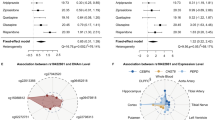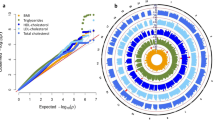Abstract
Schizophrenic patients who are treated with antipsychotics, especially second generation antipsychotics, such as clozapine and olanzapine, manifest an increase in cholesterol and triglycerides as well as other changes associated with diabetes or the metabolic syndrome. Previous studies have shown that polymorphisms in several genes that regulate lipid metabolism can influence the levels of these lipids and response to drug treatment. We have investigated in an exploratory study whether polymorphisms in the apolipoprotein C-III (ApoC3), apolipoprotein A-V gene (ApoA5) and lipoprotein lipase genes influence differential lipid response to treatment with three second generation antipsychotics—olanzapine, clozapine and risperidone—or treatment with a first generation antipsychotic. A total of 189 patients with schizophrenia or schizoaffective disorder who were being treated with a single antipsychotic were studied in a cross-sectional study design in which fasting serum cholesterol and triglycerides and selected single-nucleotide polymorphosms (SNPs) in the three lipid metabolism genes were assessed. The treatment with antipsychotic monotherapy makes drug haplotype ascertainment less complex. Our analyses showed several nominally significant drug × gene and drug × haplotype interactions. The rarer C allele or the ApoA5_1131 (T/C) SNP was associated with higher cholesterol levels in patients treated with first generation antipsychotics and lower cholesterol levels in patients treated with olanzapine or clozapine. The rarer C allele of the ApoA5_SW19 (G/C) SNP was associated with higher cholesterol in risperidone-treated patients. An ApoA5 CG haplotype was associated with decreased cholesterol in olanzapine- or clozapine-treated patients and higher cholesterol in patients treated with first generation antipsychotics. The presence of the rarer T allele of the ApoC3_1100 (C/T) SNP or the presence of the ApoC3 TG haplotype was associated with decreased triglyceride levels in patients treated with olanzapine or clozapine and a nonsignificant trend for increased triglycerides in patients treated with first generation antipsychotics. The presence of the ApoC3 CC haplotype was associated with increased triglycerides in patients treated with olanzapine or clozapine. The overall magnitude of the effects was not large. These results provide a potential initial step toward a pharmacogenetic approach to selection of antipsychotic treatment which may help minimize the side effect of increases in serum lipids.
This is a preview of subscription content, access via your institution
Access options
Subscribe to this journal
Receive 6 print issues and online access
$259.00 per year
only $43.17 per issue
Buy this article
- Purchase on Springer Link
- Instant access to full article PDF
Prices may be subject to local taxes which are calculated during checkout


Similar content being viewed by others
References
Newcomer J . Second-generation (atypical) antipsychotics and metabolic effects: a comprehensive literature review. CNS Drugs 2005; 19 (Suppl1): 1–94.
Meyer J, Koro C . The effects of antipsychotic therapy on serum lipids: a comprehensive review. Schizophr Res 2004; 70: 1–17.
Smith R, Lindenmayer J-P, Bark N, Warner-Cohen J, Vaidhyanathaswamy S, Khandat A . Clozapine risperidone, olanzapine, and conventional antipsychotic drug effects on glucose, lipids, and leptin in schizophrenic patients. Int J Neuropsychopharmacol 2005; 8: 183–194.
Busch C, Hegele R . Variation of candidate genes in triglyceride metabolism. J Cardiovasc Risk 2000; 7: 309–315.
Lusis A, Fogelamin A, Gonarow G . Genetic basis of atherosclerosis: Part II-clinical Implications. Circulation 2004; 110: 2066–2071.
Klos K, Hamon S, Clark S, Boerwinkle E, Liu K, Sing C . APOA5 polymorphisms influence plasma triglycerides in young healthy African Americans and whites of the CARDIA study. J Lipid Res 2005; 46: 564–570.
Waterworth D, Talmud P, Bujac S, Fisher R, Miller G, Humpries S . Contributions of apolipoprotein C-III gene variation to determination of triglyceride levels and interaction with smoking in middle-aged men. Aterioscler Thromb Vasc Biol 2000; 20: 2663–2669.
Xin X, Srinivasan S, Chen W, Boerwinkle E, Berenson G . Interaction effect of Serine447Stop variant of the lipoprotein lipase gene and C-514T variant of the hepatic lipase gene on serum triglyceride levels in young adults: the Bogalusa Heart Study. Metabolism 2003; 52: 1337–1342.
Chao-Qiang L, Serkalem D, Cupples L, Zhu Y, Adiconis S, Parnell L et al. Influence of the APOA5 locus on plasma triglyceride lipoprotein subclasses and CVD risk int he Framingham Heart Study. J Lipid Res 2004; 45: 2096–2105.
Knoblauch H, Bauerfeind A, Krahenbuhl C, Daury A, Rohde K, Bejanin S et al. Common haplotypes in five genes influence genetic variance of LDL and HDL cholesterol in the general population. Hum Mol Genet 2002; 11: 1477–1485.
Schmitz G, Langmann T . Pharmacogenetics of cholesterol-lowering therapy. Vascul Pharmacol 2006; 44: 75–89.
Lieberman J, Stroup T, McEvoy J, Swartz M, Rosenheck R, Perkins D et al. Effectiveness of antipsychotic drugs in patients with chronic schizophrenia. N Engl J Med 2005; 353: 1209–1223.
McEvoy J, Lieberman J, Stroup T, Davis S, Meltzer H, Rosenheck R et al. Effectiveness of clozapine vs olanzapine, quetiapine and risperidone in patients with chronic schizophrenia who did not respond to prior atypical antipsychotic treatment. Am J Psychiatry 2006; 163: 600–610.
Chakos M, Lieberman J, Hoffman E, Bradford D, Sheitman B . Effectiveness of second-generation antipsychotics in patients with treatment-resistant schizophrenia: a review and meta-analysis of randomized trials. Am J Psychiatry 2001; 158: 518–526.
Tollefson G, Birkett M, Kiesler G, Wood A, Group LRSS . Double-blind comparison of olanzapine versus clozapine in schizophrenic patients clinically eligible for treatment with clozapine. Biol Psychiatry 2001; 49: 52–63.
Volavka J, Czobor P, Sheitman B, Lindenmayer J, Citrome L, McEvoy J et al. Clozapine, olanzapine, risperidone and haloperidol in treatment of patients with chronic schizophrenia and schizoaffective disorder. Am J Psychiatry 2002; 159: 255–262.
Meltzer H . The role of serotonin in antipsychotic drug action. Neuropsychopharmacology 1999; 21: 106S–115S.
Bymaster F, Calligaro D, Falcone J, Marsh R, Moore N, Tye N et al. Radioreceptor binding profile of the atypical antipsychotic olanzapine. Neuropsychopharmacology 1996; 14: 87–96.
Bymaster F, Felder C, Tzavaam E, Nomikos G, Calligaro D, McKenzie D . Muscarinic mechanisms of antipsychotic atypicality. Prog Neuropsychopharmacol Biol Psychiatry 2003; 27: 1125–1143.
Kim S, Huang A, Snowman A, Tuescher C, Snyder S . Antipsychotic drug-induced weight gain mediated by histamine H1 receptor-lined activation of hypothalamic AMP-kinase. Proc Natl Acad Sci USA 2007; 104: 3456–3459.
Dallongeville J, Cottel D, Montaye M, Codron V, Amouyel P, Helbecque N . Impact of Apo A5/A4/3 genetic polymorphisms on lipid variables and cardiovascular disease risk in French men. Int J Cardiology 2006; 106: 152–156.
Hokanson J . Functional variants in the lipoprotein lipase gene and risk of cardiovascular disease. Current Opin Lipidol 1999; 10: 393–399.
Kastelein J, Ordovas J, Wittekoek M, Pimstone S, Wilson W, Gagne S et al. Two common mutations (D9N, N291S) in lipoprotein lipase: a cumulative analysis of their influence on plasma lipids and lipoproteins in men and women. Clin Genet 1999; 56: 297–305.
Razzaghi H, Aston C, Hamman R, Kamboh M . Genetic screening of the lipoprotein lipase gene for mutations associated with high triglyceride/low HDL-cholesterol levels. Hum Genet 2000; 107: 257–267.
Baroni M, Berni A, Romeo S, Marcello A, Tesorio T, Sorropago G et al. Genetic study of common variants at the Apo E Apo A1, Apo CIII, Apo B, lipoprotein lipase(LPL) and hepatic lipase (LIPC) genes and the coronary artery disease (CAD): variation in LIPC gene associates with clinical outcomes in patients with established CAD. MBC Med Genet 2003. Http://www.biomedcentral.com/1471-2350/4/8.
Kathy L, Klos C, Sing C, Boerwinkle E, Hamon S, Rea T et al. Consistent effects of genes involved in reverse cholesterol transport on plasma lipid and apolipoprotein levels in CARDIA participants. Arterioscler Thromb Vasc Biol 2006; 26: 1828–1836.
Lindi V, Schwab U, Louheranta AML, Vessby B, Hermansen K, Storlien L et al. Impact of the Pro12Ala polymorphism of the PPAR-gamma2 gene on serum triacylglycerol response to n-3 fatty acid supplementation. Mol Genet Metab 2003; 79: 52–60.
Reynolds G, Hill M, Kirk S . The 5-HT2C receptor and antipsychotic induced weight gain—mechanisms and genetics. J Psychopharmcol 2006; 20 (4 Suppl): 15–18.
Reynolds G, Zhang Z, Zang X . Polymorphism of the promotor region of the serotonin 5-HT(2C) receptor gene and clozapine-induced weight gain. Am J Psychiatr 2003; 160: 677–679.
Templeman L, Reynolds G, Arranz B, San L . Polymorphisms of the 5-HT2C receptor and leptin genes are associated with antipsychotic induced weight gain in Caucasian subjects with first-episode psychosis. Pharmacogenet Genomics 2005; 15: 193–194.
Park Y, Chung Y, Lee S, Lee S, Kim H, Byun Y et al. Weight gain associated with the alpha2a-adrenergic receptor-1, 291 C/G polymorphism and olanzapine treatment. Am J Med Genetics B Neuropsychaitr Genet 2006; 141: 394–397.
Zang Y, Wat N, Stratton I, Warren-Perry M, Orho M, Groop L et al. UKPDS 19: heterogeneity in NIDDM: separate contributions of IRS-1 and β3-adrenergic-receptor mutations to insulin resistance and obesity respectively with no evidence of glycogen synthase gene mutations. Diabetologia 1996; 39: 1505–1511.
Corella D, Guillen M, Saiz C, Portoles O, Sabater A, Folch J et al. Associations of LPL and ApoC gene polymorphisms on plasma lipids in a Mediterranean population: interaction with tobacco smoking and APOE locus. J Lipid Res 2002; 43: 416–427.
Talmud P, Hawe E, Robertson K, Miller G, Miller N, Humphries S . Genetic and environmental determinants of plasma high density lipoprotein cholesterol and apolipoprotein AI concentrations healthy middle-aged men. Ann Hum Genet 2002; 66: 111–124.
Groenendijk M, Cantor R, de Bruin TD, Allinga-Thie G . The apoAI-CIII-AIV gene cluster. Atherosclerosis 2001; 157: 1–11.
Acknowledgements
This study was supported in part by an Independent Investigator Grant from Eli Lily, RS (MD PhD), Principal Investigator. RS designed the study and all study procedures, statistical analyses and manuscript preparation were carried out independently by Dr Smith and his coauthors. Dr Jan Volavka, Dr Les Citrome and Ms Linda Kline provided assistance in implementing the study at one of the three sites (Nathan Kline Institute). Dr Nigel Bark provided assistance in implementing the study at one of the three sites (Bronx Psychiatric Center). Dr Jean-Pierre Lindenmayer, Dr Sumathi Vaidhyanathaswamy and Dr Amaresh Khandat provided assistance in implementing the study at one of the three sites (Manhattan Psychiatric Center).
Author information
Authors and Affiliations
Corresponding author
Additional information
Duality of Interest
Dr Smith has received research grants and travel support from Eli Lilly. The co-authors report no potential conflicts of interest in regard to the study.
Supplementary Information accompanies the paper on the The Pharmacogenomics Journal website (http://www.nature.com/tpj)
Supplementary information
Rights and permissions
About this article
Cite this article
Smith, R., Segman, R., Golcer-Dubner, T. et al. Allelic variation in ApoC3, ApoA5 and LPL genes and first and second generation antipsychotic effects on serum lipids in patients with schizophrenia. Pharmacogenomics J 8, 228–236 (2008). https://doi.org/10.1038/sj.tpj.6500474
Received:
Revised:
Accepted:
Published:
Issue Date:
DOI: https://doi.org/10.1038/sj.tpj.6500474
Keywords
This article is cited by
-
Metabolic Effects of Aripiprazole and Olanzapine Multiple-Dose Treatment in a Randomised Crossover Clinical Trial in Healthy Volunteers: Association with Pharmacogenetics
Advances in Therapy (2021)
-
Altered apolipoprotein C expression in association with cognition impairments and hippocampus volume in schizophrenia and bipolar disorder
European Archives of Psychiatry and Clinical Neuroscience (2017)
-
Association of common genetic variants with risperidone adverse events in a Spanish schizophrenic population
The Pharmacogenomics Journal (2013)
-
A randomized, 12-week study of the effects of extended-release paliperidone (paliperidone ER) and olanzapine on metabolic profile, weight, insulin resistance, and β-cell function in schizophrenic patients
Psychopharmacology (2013)
-
Potential mechanisms of atypical antipsychotic-induced hypertriglyceridemia
Psychopharmacology (2013)



